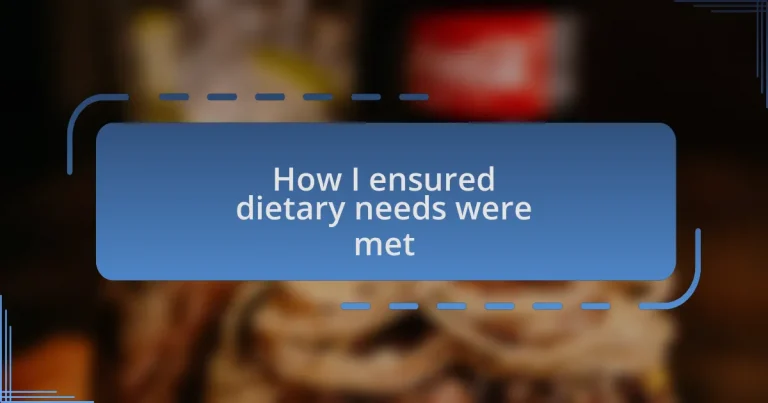Key takeaways:
- Understanding and accommodating diverse dietary needs fosters community and enhances customer experiences.
- Menu variety is essential for catering to different tastes and dietary restrictions, encouraging customer satisfaction and repeat business.
- Active communication with customers, including feedback and clear allergen information, builds trust and connection.
- Continuous improvement based on customer suggestions shapes the menu and cultivates a welcoming atmosphere.
Author: Olivia Hartwell
Bio: Olivia Hartwell is a contemporary fiction author known for her compelling narratives and vivid characterizations. With a background in literature and creative writing, she has a keen eye for detail and a passion for exploring the complexities of human relationships. Olivia’s debut novel, Whispers of the Heart, received critical acclaim and was nominated for several literary awards. When she’s not writing, she enjoys hiking in the mountains of Colorado and sipping artisanal coffee at local cafes. Olivia resides in Denver with her beloved rescue dog, Rosie.
Understanding dietary needs
Understanding dietary needs is essential for creating an inclusive dining experience. I remember when a close friend of mine went vegan; at first, I was unsure how to accommodate that change. It opened my eyes to the importance of recognizing different dietary preferences and restrictions, especially in a diverse food truck environment.
Often, I find myself wondering how many people truly understand their unique dietary requirements. For instance, allergies can be life-threatening, and people with gluten intolerance experience discomfort that can ruin their day. The more I learn about these issues, the more driven I become to provide menu options that allow everyone to enjoy a meal without worry.
In my experience, engaging with customers about their dietary needs fosters a sense of community. Recently, after speaking with a patron about their lactose intolerance, I was able to suggest alternatives that made their meal enjoyable. This connection deepened not only their customer experience but also my understanding of the various dietary needs within our community.
Importance of menu variety
Menu variety plays a crucial role in ensuring that everyone can find something they enjoy. I remember one bustling afternoon by the truck when a family approached, and the parents were scrambling to include both their picky eater and their health-conscious teenager. By offering different protein options—like a turkey burger, a veggie patty, and classic beef—I was able to create a harmonious meal that satisfied all tastes. It felt incredible to watch them happily dive into their choices.
Having an array of options not only accommodates dietary needs but also enhances customer satisfaction. There was a time I experimented with a special weekend menu that featured international flavors. The thrill I saw on a customer’s face when they tried our Mediterranean-inspired burger was unforgettable. This small change not only attracted new patrons, but it also sparked conversations about culinary exploration and preferences, making the dining experience much richer.
Moreover, when I think about menu variety, I realize it can drive repeat business. Customers often return when they know they have choices that cater to their specific needs or cravings. A while back, a repeat customer shared how our inclusion of gluten-free bread made it easy for her to enjoy eating out without fear or discomfort. It’s those kinds of moments that solidify loyalty and give deeper meaning to what we serve. Wouldn’t you agree that food is more than just nourishment? It’s about connection and enjoyment too.
Identifying common dietary restrictions
Identifying common dietary restrictions is essential for any culinary venture. From my experience, I’ve learned that many customers today are navigating allergies, intolerances, or lifestyle choices such as veganism. For instance, I recall a time when a customer approached me, concerned about lactose in our cheese. That moment stressed the need for clear communication; I offered a dairy-free alternative, which not only resolved her dilemma but also sparked a conversation about vegan options.
I’ve also noticed the increasing prevalence of gluten sensitivities. A memory stands out when a regular patron excitedly shared how hard it was to find safe gluten-free options elsewhere. This feedback pushed me to dedicate a section of my menu to gluten-free choices. It was rewarding to see her relief when I introduced a unique burger using a gluten-free bun that didn’t compromise on taste.
It’s clear that people appreciate when their dietary needs are recognized and catered to. Last week, a young couple shared their journey with food intolerances and how grateful they were to find a truck that took those challenges seriously. Conversations like these not only deepen customer relationships but inspire me to continue adapting our offerings. After all, isn’t it fulfilling to create an environment where everyone feels welcomed and cared for?
Creative options for dietary needs
Exploring creative options for dietary needs has been one of the most rewarding aspects of running my gourmet burger truck. One day, I met a regular customer who was constantly seeking out tasty vegan alternatives. To accommodate her, I experimented with a black bean and quinoa patty that surprised not only her but everyone who tried it. The joy on her face when I unveiled the new option reminded me why it’s crucial to think outside the box.
I always look for ways to elevate classic favorites while still catering to diverse dietary requirements. I recall a time when a gluten-free dad brought his son to my truck, and I decided to whip up a burger topped with avocado, fresh salsa, and a spicy aioli on a gluten-free bun. The look of delight on both their faces as they savored that burger inspired me to keep pushing the boundaries of flavor while ensuring everyone at my truck could indulge without worry.
In my experience, it’s essential to listen to customers and embrace their feedback. I once initiated a poll on social media to invite suggestions for special dietary options. The outpouring of ideas, from grain-free patties to nut-free toppings, blew me away and showed me how eager people are to share their preferences. Connecting with my community not only drives creativity but also fosters a warm, inclusive environment that makes every visit memorable. Isn’t it amazing when food brings us all together, despite different dietary needs?
Communicating with customers effectively
When it comes to effectively communicating with customers, I find that openness is key. I often take a moment to chat with folks waiting in line, asking about their dietary preferences. Just last week, I spoke with a customer who had specific nut allergies. By showing genuine interest in her needs, I tailored my recommendations, ensuring she felt confident and safe choosing a meal from my menu.
Another approach I’ve found effective is utilizing clear signage and menus. I remember once changing my menu board to highlight allergen information prominently. This small adjustment not only alleviated concerns for customers with dietary restrictions but also sparked conversations. They appreciated the transparency, and I felt a greater connection with my patrons, knowing they appreciated the effort.
Additionally, actively engaging with customers via social media has transformed my communication style. I love sharing behind-the-scenes looks at recipe development while encouraging feedback. One particularly memorable instance was when I posted a picture of a new spicy veggie burger, inviting opinions. The enthusiastic comments I received not only made me feel supported but also provided valuable insights about what my community truly craves. Isn’t it incredible how a simple question can lead to deeper connections?
Personal experiences and adjustments
I remember a time when a loyal customer approached me about their vegetarian lifestyle, which had recently transitioned to a vegan diet. It was a challenge at first, as my menu was primarily geared towards meat-based options. However, instead of feeling overwhelmed, I saw it as an opportunity to innovate. I experimented with different plant-based ingredients to craft a vegan burger that still packed that gourmet punch. Seeing their face light up when they tried it was a rewarding moment that reminded me of the power of adaptability.
Another adjustment I’ve made stems from a conversation with a parent whose child has gluten sensitivity. At first, I hadn’t considered gluten-free options as a significant part of my menu. Their honesty sparked a realization in me: if I wanted families to feel welcome, I needed to diversify my offerings. So, I got creative in the kitchen, developing a gluten-free bun that has quickly become a favorite among my patrons. Isn’t it fascinating how customer feedback can not only drive menu changes but also forge a sense of community?
The emotional connection I build with my customers has also shaped my approach to dietary needs. I recall a moment when a guest expressed heartfelt gratitude for a custom meal I prepared for them, accommodating their strict dietary restrictions. It struck me how these personal interactions are more than just business transactions; they are moments where I can make a real difference in someone’s experience. How fulfilling it is to create a space where everyone feels valued!
Feedback and continuous improvement
Gathering feedback has been an essential part of my journey in running the Gourmet Burger Truck. I remember a day when a customer suggested a spice level adjustment for one of my signature burgers. Their candidness not only improved the dish but also reminded me how crucial it is to listen. Have you ever considered how a single suggestion can elevate an entire menu?
Continuous improvement isn’t just about making one change; it’s about creating an ongoing dialogue with my patrons. After implementing a few tweaks based on feedback, I noticed more repeat customers actively engaging with my menu. It’s exciting to witness this dynamic relationship evolve—who wouldn’t want to dine at a place where their voice truly matters?
Reflecting on the past few months, I’ve realized that each piece of feedback, regardless of how small, is a stepping stone toward enhancing the dining experience. Engaging with my customers about their culinary preferences has fostered a deeper connection and has motivated me to consistently refresh my offerings. Isn’t it rewarding to know that, through our interactions, we’re not just serving food but also crafting a community?


